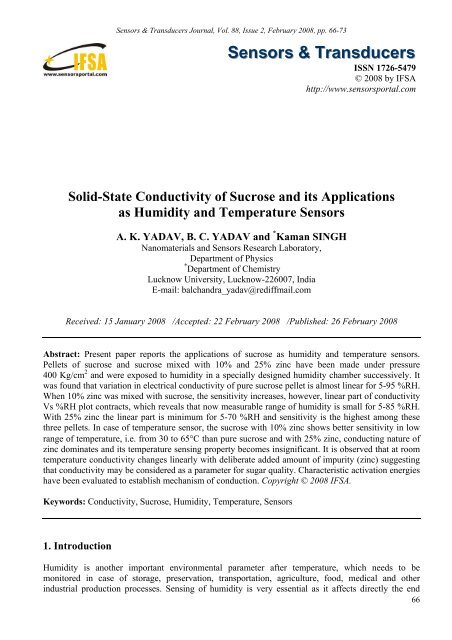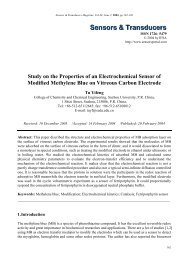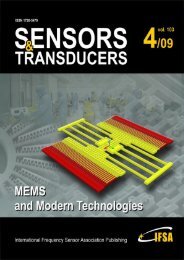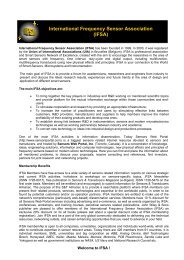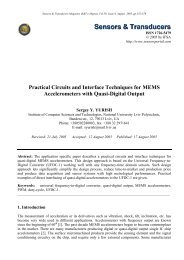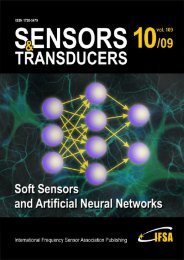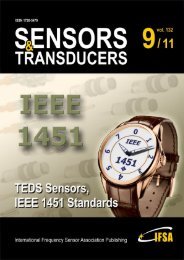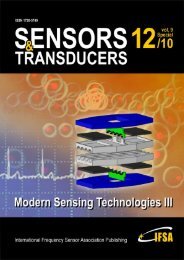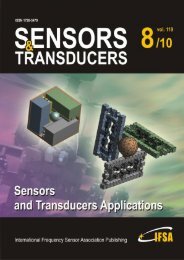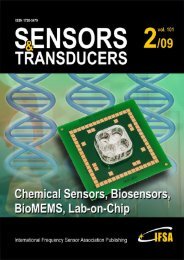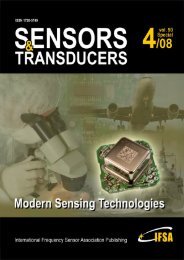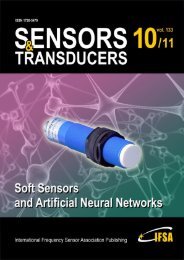Solid-State Conductivity of Sucrose and its Applications as Humidity ...
Solid-State Conductivity of Sucrose and its Applications as Humidity ...
Solid-State Conductivity of Sucrose and its Applications as Humidity ...
You also want an ePaper? Increase the reach of your titles
YUMPU automatically turns print PDFs into web optimized ePapers that Google loves.
Sensors & Transducers Journal, Vol. 88, Issue 2, February 2008, pp. 66-73<br />
Sensors & Transducers<br />
ISSN 1726-5479<br />
© 2008 by IFSA<br />
http://www.sensorsportal.com<br />
<strong>Solid</strong>-<strong>State</strong> <strong>Conductivity</strong> <strong>of</strong> <strong>Sucrose</strong> <strong>and</strong> <strong>its</strong> <strong>Applications</strong><br />
<strong>as</strong> <strong>Humidity</strong> <strong>and</strong> Temperature Sensors<br />
A. K. YADAV, B. C. YADAV <strong>and</strong> * Kaman SINGH<br />
Nanomaterials <strong>and</strong> Sensors Research Laboratory,<br />
Department <strong>of</strong> Physics<br />
* Department <strong>of</strong> Chemistry<br />
Lucknow University, Lucknow-226007, India<br />
E-mail: balch<strong>and</strong>ra_yadav@rediffmail.com<br />
Received: 15 January 2008 /Accepted: 22 February 2008 /Published: 26 February 2008<br />
Abstract: Present paper reports the applications <strong>of</strong> sucrose <strong>as</strong> humidity <strong>and</strong> temperature sensors.<br />
Pellets <strong>of</strong> sucrose <strong>and</strong> sucrose mixed with 10% <strong>and</strong> 25% zinc have been made under pressure<br />
400 Kg/cm 2 <strong>and</strong> were exposed to humidity in a specially designed humidity chamber successively. It<br />
w<strong>as</strong> found that variation in electrical conductivity <strong>of</strong> pure sucrose pellet is almost linear for 5-95 %RH.<br />
When 10% zinc w<strong>as</strong> mixed with sucrose, the sensitivity incre<strong>as</strong>es, however, linear part <strong>of</strong> conductivity<br />
Vs %RH plot contracts, which reveals that now me<strong>as</strong>urable range <strong>of</strong> humidity is small for 5-85 %RH.<br />
With 25% zinc the linear part is minimum for 5-70 %RH <strong>and</strong> sensitivity is the highest among these<br />
three pellets. In c<strong>as</strong>e <strong>of</strong> temperature sensor, the sucrose with 10% zinc shows better sensitivity in low<br />
range <strong>of</strong> temperature, i.e. from 30 to 65°C than pure sucrose <strong>and</strong> with 25% zinc, conducting nature <strong>of</strong><br />
zinc dominates <strong>and</strong> <strong>its</strong> temperature sensing property becomes insignificant. It is observed that at room<br />
temperature conductivity changes linearly with deliberate added amount <strong>of</strong> impurity (zinc) suggesting<br />
that conductivity may be considered <strong>as</strong> a parameter for sugar quality. Characteristic activation energies<br />
have been evaluated to establish mechanism <strong>of</strong> conduction. Copyright © 2008 IFSA.<br />
Keywords: <strong>Conductivity</strong>, <strong>Sucrose</strong>, <strong>Humidity</strong>, Temperature, Sensors<br />
1. Introduction<br />
<strong>Humidity</strong> is another important environmental parameter after temperature, which needs to be<br />
monitored in c<strong>as</strong>e <strong>of</strong> storage, preservation, transportation, agriculture, food, medical <strong>and</strong> other<br />
industrial production processes. Sensing <strong>of</strong> humidity is very essential <strong>as</strong> it affects directly the end<br />
66


